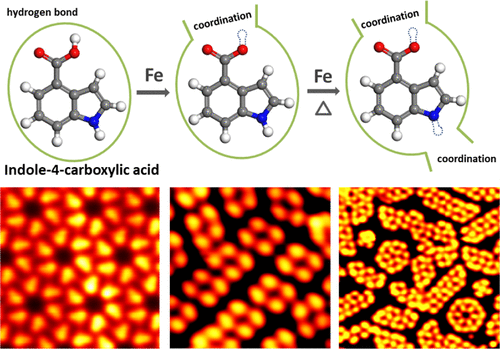当前位置:
X-MOL 学术
›
J. Phys. Chem. C
›
论文详情
Our official English website, www.x-mol.net, welcomes your feedback! (Note: you will need to create a separate account there.)
Self-Assembly of a Metal–Organic Framework by Stepwise Coordination of Carboxyl and Pyrrolyl Groups
The Journal of Physical Chemistry C ( IF 3.7 ) Pub Date : 2020-03-30 , DOI: 10.1021/acs.jpcc.9b11599 Qiang Xue 1 , Na Xue 2 , Jie Li 2 , Yaru Li 2 , Ruoning Li 1 , Yajie Zhang 1 , Na Li 1 , Ziyong Shen 1 , Shimin Hou 1 , Yongfeng Wang 1, 3
The Journal of Physical Chemistry C ( IF 3.7 ) Pub Date : 2020-03-30 , DOI: 10.1021/acs.jpcc.9b11599 Qiang Xue 1 , Na Xue 2 , Jie Li 2 , Yaru Li 2 , Ruoning Li 1 , Yajie Zhang 1 , Na Li 1 , Ziyong Shen 1 , Shimin Hou 1 , Yongfeng Wang 1, 3
Affiliation

|
The coordination abilities of different functional groups play fundamental roles in metal–organic frameworks. The coordination of indole-4-carboxylic acid with Fe on surfaces was investigated by scanning tunneling microscopy and density functional theory. The carboxyl group reacted with Fe atoms to form tetramers in a deprotonation process on Au(111) at room temperature. The deprotonation of pyrrolyl groups occurred at around 350 K, forming coordinated tetramer chains and rotiform structures. The arrangement of tetrameric clusters and coordination chains on Au(100) was influenced by surface reconstitution. A two-dimensional coordination network was obtained on Ag(111) without the influence of surface reconstitution.
中文翻译:

通过逐步配位羧基和吡咯基团对金属有机骨架进行自组装
不同官能团的协调能力在金属有机框架中起着基本作用。通过扫描隧道显微镜和密度泛函理论研究了吲哚-4-羧酸与铁在表面的配位作用。羧基在室温下在Au(111)上的去质子化过程中与Fe原子反应形成四聚体。吡咯基的去质子化发生在约350 K,形成配位的四聚体链和旋转状结构。四聚体簇和配位链在Au(100)上的排列受到表面重构的影响。在表面重构的影响下,在Ag(111)上获得了二维配位网络。
更新日期:2020-03-30
中文翻译:

通过逐步配位羧基和吡咯基团对金属有机骨架进行自组装
不同官能团的协调能力在金属有机框架中起着基本作用。通过扫描隧道显微镜和密度泛函理论研究了吲哚-4-羧酸与铁在表面的配位作用。羧基在室温下在Au(111)上的去质子化过程中与Fe原子反应形成四聚体。吡咯基的去质子化发生在约350 K,形成配位的四聚体链和旋转状结构。四聚体簇和配位链在Au(100)上的排列受到表面重构的影响。在表面重构的影响下,在Ag(111)上获得了二维配位网络。



























 京公网安备 11010802027423号
京公网安备 11010802027423号